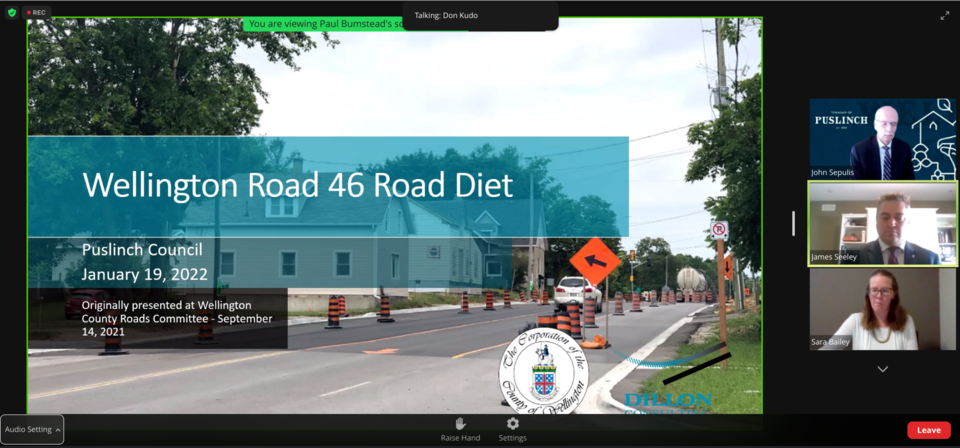PUSLINCH - Council is still hesitant on the controversial County of Wellington’s proposed recommendations for the “road diet” design through the community of Aberfoyle as part of its Road Master Action Plan (RMAP) project.
At Wednesday’s meeting, council received the Wellington County RMAP’s Wellington Road 46 Road Diet as information, which county engineer Don Kudo presented over Zoom.
“The goal of the presentation is to assess the potential effects of a proposed “road diet” through the community of Aberfoyle,” said Kudo during his presentation.
“Essentially, a road diet is the conversion of the existing four-lane cross-section. It consists of the two travel lanes in each direction between Wellington Road 34 and Gilmour Road, merging into a single travel lane in each direction with a two-way centre left-turn lane and a parking lane.”
Currently, Wellington Road 46 is experiencing traffic issues as it is considered a major arterial roadway. Traffic coming from Highway 401, McLean Road, Wellington Road 34, and Maltby Road all go through Wellington Road 46.
“Between Malty Road to Wellington Road 34, where the cross section of Wellington Road 46 is reduced to two-lanes, volumes are approaching levels where the flow is unstable and minor incidents can cause delays,” explained Kudo.
“Any reduction in capacity on Wellington Road 46 through Aberfoyle will result in a significant volume increase on adjacent non-county roadways.”
Kudo also explained that the Morriston by-pass is likely to result in some reduction in volume in the Wellington Road 46 corridor, but it will not be significant enough to justify reduced capacity.
As such, a road diet through the community of Aberfoyle is feasible from a strategic capacity perspective.
“I understand this was a pretty high level report, but I feel there would be situations where yes, it’s a good strategic solution but driving with the proposed recommendations in place such as the removal of the stop light at Sleeman, is quite an insufficient way to go,” said Mayor James Seeley.
Coun. John Sepulis noted many times the environmental assessment (EA) studies county staff suggest townships do are oftentimes far apart from the construction timeline, such as the EA study on Gordon Street, which was done in 2000.
“When we studied the report, it revealed the need for a four lane section on Wellington Road 46. We compare them and we know what we have on the ground today and we know what the policy position is in terms of growth looking forward,” replied Paul Bumstead, technical consultant for Dillon Consulting Ltd.
“The EA does have a shelf time but we put our effort and costs where we think the important information can be retrieved from. We usually do EA studies for two years and construction usually takes place around three to five years, so realistically, there’s not that big of a gap.”
Councillors expressed that the road diet doesn’t seem to work as it will only divert traffic from one section of the road to another.
Kudo noted that since the impacts of the road diet on adjacent municipal roads network is not desirable from an operational and road safety perspective, the county will be reviewing and studying alternative methods and design concepts once future infrastructure and services are implemented from its proposed RMAP recommendations.
